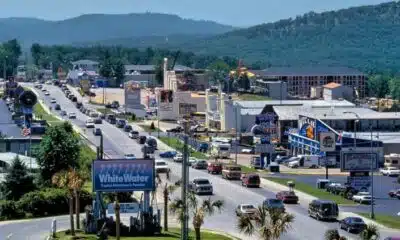News from the South - North Carolina News Feed
Buildings across NC constructed in brutalist style slowly going away
Razing concern: NC’s brutalist era is slowly ending — for better or worse
RALEIGH — Among the scores of buildings here, the city will soon lose its “ugliest.”
At least that’s the description some residents have bestowed, somewhat admiringly, upon the ill-fated Bath Building, which sits adjacent to the downtown state government complex.
This cube of concrete was constructed in 1975 to house laboratories used by the state health department. Within its walls, technicians performed a variety of procedures, from human cytology to tests for rabies and HIV.
It is an instantly recognizable work of brutalist architecture, with its blocky geometry and plain concrete exterior. Notably, there are no windows above the ground floor — a major bummer for the state employees who worked there after most of the labs moved out and were replaced by offices for unrelated departments sometime in the 2010s.
Eventually, it became vacated and scheduled for demolition. In the past year, crews have stripped the insides and removed the windows.
Sometime in March it will fall.
In reality, the Bath Building isn’t quite the visual abomination some have made it out to be. On a clear day, just before the sun sets, the western side of the building becomes masked in a golden glow. The stains and imperfections endured by 50 years of weather are washed away, and the structure stands a little prouder, its angles sharper, even in its dying days.
Perhaps that viewpoint is simply tinted by the nostalgia that comes with knowing that something will soon be gone forever.
But the Bath Building is not unique in that regard.
Buildings raised — then razed
Generations of buildings have been raised, then razed, during the slow and constant process of urban development. More than five decades after their heyday, the brutalist buildings of North Carolina now face this existential threat.
The architectural movement, once embraced especially by local and state governments in the 1970s, has a complicated legacy as the most publicly-maligned styles of building.
But when the physical legacy of the brutalist movement is torn down, what goes with it?
With a unique history as a hotbed for modern architecture in the American South, North Carolina is a fascinating place to explore that question.
City Hall in Greensboro.
The 129 West Trade building in Charlotte.
A collection of government office buildings surrounding Halifax Mall in Raleigh.
They’re all prime examples of brutalism.
Raw concrete, or béton brut in French, is the etymological origin of the term.
As one might guess, the buildings of this style were typically constructed using the material from which it gets its name. Raw concrete differs from finished concrete in that it keeps all the blemishes imprinted during the casting process.
Brutalist buildings often are modular and might take on the appearance of stacked blocks. They are rarely any other color than gray. The interiors of these buildings typically feature expansive open space and may have purposefully exposed pipes and wiring.
But … why? Is there any real purpose to this unsightly aesthetic?
A brutalist beginning
Yes, argues Burak Erdim, an N.C. State architecture professor. His research at the College of Design focuses on the history of modernity (a fascinatingly oxymoronic topic) and urbanism.
Brutalism emerged in Europe, particularly England, following the devastation from World War II. Not only was it cheap and practical, the style also represented the type of society Western nations hoped would rise out of the ruins of war.
“Postwar England, as well as many non-aligned Third World and decolonizing nations, (used brutalism) to convey their aspirations towards building a more democratic state and society through this expression of honest use of materials and associated a kind of morality with this use of rawness,” Erdim explained to Carolina Public Press. “In a similar vein, many federal, state and city governments in the United States also adopted this style to convey symbols of transparency, honesty and even thrift.”
Brutalism was just one offshoot of the expansive collection of architectural styles that, together, are referred to as modern architecture. It has become a pejorative term often misused by the general public to describe any building made of concrete that they deem an eyesore.
Ironically, the brutalist style was intended to be a shift away from a similar style that it’s often confused with. International architecture uses much of the same material palette as brutalism, but came to be associated with “American corporate power, consumerism and neo-colonialism,” Erdim said.
The brutalist style took root in America during the 1950s and remained popular through the mid-1970s, primarily with government buildings and university campuses. Its strongest influence was in the northeast, but eventually its influence trickled south and crossed over the Mason-Dixon line.
An urban legend is born
Paul Rudolph, who chaired Yale’s Department of Architecture, was perhaps America’s finest practitioner of the style. His government offices in Boston and campus buildings in New Haven made brutalism a staple of the New England urban landscape.
But one of his most ambitious works was erected in none other than Research Triangle Park near Raleigh.
The Elion-Hitchings Building, completed in 1972, was a brutalist behemoth built to be the U.S. headquarters of London-based pharmaceutical company Burroughs Wellcome. Its large size — 300,000 square feet to be exact — and unique aesthetic helped establish the Research Triangle as a nationally-renowned technology hub.
The growth of Charlotte into a banking center and the establishment of N.C. State’s College of Design in 1948 — led by visionary architect Henry Kamphoefner — further modernized North Carolina’s cityscapes.
As Erdim described it, Kamphoefner brought a “Noah’s Ark” of colleagues with him from Oklahoma University to the new design school in Raleigh to be a part of the inaugural faculty. He brought them not only to teach, but to build.
And build they did.
Buildings lost in translation
Eduardo Catalano designed Greensboro’s City Hall. Matthew Nowicki devised the plans for the striking Dorton Arena on the State Fairgrounds in Raleigh. George Matsumoto created offices for IBM in Winston-Salem.
The original design school faculty were responsible for a great number of modern residences in the growing Raleigh suburbs. Others served as consultants for numerous construction projects at the state government complex in downtown Raleigh, which included the Bath Building.
Kamphoefner’s tenure as dean at the College of Design, which lasted from 1948 to 1972, coincided neatly with a golden age of modernist architecture in the United States.

By the time he retired, the brutalist buildings of North Carolina had become less of a novelty and more of a fixture of the built environment. But along with that familiarity came more criticism from the masses.
“The symbolisms of honesty, transparency and thrift that these buildings were supposed to convey never really communicated accurately to the general public,” Erdim said.
That disconnect may have not only been for aesthetic reasons, but also cultural ones. To some, the buildings seemed imposing, authoritative and even lavish.
“They became associated with notions of big government or at least an interventionist state,” Erdim explained.
History in the breaking
By the turn of the millennium, modernist buildings across the country started to be torn down.
In 2006, the old Raleigh Civic Center — a massive concrete venue designed by A.G. Odell, one of North Carolina’s most prolific architects — was leveled.
The Elion-Hitchings Building, Rudolph’s brutalist masterwork at Research Triangle Park — was demolished in 2021 despite an outcry.
Without comprehensive records, it’s difficult to say how many lesser-known brutalist works came down in the 15 years between the death of those buildings.
Over the years, many older buildings that were built using raw concrete began to show their age. Their exteriors became stained by rain and dirt. Some literally began to crumble — consequences of their cheap construction material.
The cost of maintenance was too much compared to the price of building something new.
Another reason for these buildings’ lack of staying power was their overcommitment to specific functions, Erdim said.
“Form follows function,” is a cliché inherent to the brutalist ethic. It means that the form of a building should mirror its intended purpose. In other words, a bank should look like a bank, a library like a library and so on.
That was the story of the Bath Building. When the state laboratories were removed, its form was no longer in harmony with its function.
“When a building is too closely wrapped around a particular function, it can ultimately make it very difficult to then allow that building to house another function,” Erdim said.
So, with everything we know now, is it safe to call the brutalist movement a failure?
That question gave Erdim pause.
Then he countered: “What is successful? Maybe, in telling the truth, it was successful by trying not to be pleasing. Maybe it succeeded.”
This article first appeared on Carolina Public Press and is republished here under a Creative Commons license.
The post Buildings across NC constructed in brutalist style slowly going away appeared first on carolinapublicpress.org
News from the South - North Carolina News Feed
Updated COVID vaccine approval adds restrictions for some patients
SUMMARY: As fall approaches, updated FDA guidelines restrict COVID-19 vaccine eligibility primarily to those 65 and older or younger high-risk individuals with underlying conditions like asthma, diabetes, or heart issues. Raleigh pharmacy manager Santa Rita Christian notes customers must meet these criteria or have a prescription. The CDC will review these updates next month, influencing insurance coverage. CVS now requires prescriptions for vaccines in North Carolina and 12 other states due to unclear ACIP guidance, causing pharmacy confusion. Health experts urge parents to consult healthcare providers about risks, especially for young children and high-risk contacts.
The vaccines are approved for use in people 65 and older, as well as those younger with at least one health condition that makes them high-risk.
https://abc11.com/post/newest-covid-vaccine-approval-adds-restrictions-patients/17686262/
Download: https://abc11.com/apps/
Like us on Facebook: https://www.facebook.com/ABC11/
Instagram: https://www.instagram.com/abc11_wtvd/
Threads: https://www.threads.net/@abc11_wtvd
TIKTOK: https://www.tiktok.com/@abc11_eyewitnessnews
X: https://x.com/ABC11_WTVD
News from the South - North Carolina News Feed
BRIC program cuts leave NC communities in limbo
Dozens of North Carolina communities are in limbo after FEMA canceled more than $200 million worth of grants for flood-mitigation projects earlier this year in the Building Resilient Infrastructure and Communities Grant program, also known as BRIC.
For Forest City in Rutherford County, the now defunct grant program was meant to be a safety net. Flooding along the Second Broad River exposed the area’s vulnerability to heavy rainfall five years ago, when rising water smashed debris into a main line and cut off running water to Forest City and the nearby towns of Ellenboro and Bostic.
Repair work following the storm revealed more problems.
[Subscribe for FREE to Carolina Public Press’ alerts and weekend roundup newsletters]
Erosion along the river left Forest City’s sewer system and raw water intake at risk of flood damage, but the town didn’t have the money to fix it. Federal emergency management officials told town officials that they would be a good fit for a new grant program aimed at pre-disaster mitigation.
Through its Building Resilient Infrastructure and Communities Grant program, FEMA awarded Forest City $2.6 million for improvements to the town’s water and sewer systems. The project was well into the planning and design process when the federal government revoked the grant.
FEMA announced the end of the BRIC program and canceled all applications from fiscal years 2020 through 2023 on April 4, calling the program created during President Donald Trump’s first term “wasteful and ineffective” in press releases.
In total, 72 North Carolina communities with active BRIC-funded projects worth about $225 million were affected.
Town officials across the state told Carolina Public Press that the mitigation projects they view as essential to keeping their communities safe are now caught in a federal political battle in Washington.
“I don’t consider water and sewer projects to be political or woke,” Town Manager Janet Mason said.
Neither did a bipartisan group of 80 members of Congress, which released a letter addressed to Secretary of Homeland Security Kristi Noem and acting FEMA Administrator David Richardson shortly after the grant program’s termination, urging them to reverse the decision.
“BRIC funds are spurring communities across the country to strengthen their resilience to extreme weather, and forgoing these critical investments will only make it harder and more expensive for communities to recover from the next storm,” the letter read.
Instead, the legislators suggested that FEMA and Congress work together to improve the grant program’s application review and funding distribution processes.
Sen. Thom Tillis and Rep. Chuck Edwards, both North Carolina Republicans, helped craft the letter. Rep. Don Davis, a Democrat representing the northeastern part of the state, and Rep. Alma Adams, a Democrat representing Charlotte, were the other two members of North Carolina’s Congressional delegation to add their signatures.
The Department of Homeland Security did not respond to CPP’s request for a comment on pushback from lawmakers and local governments over the ending of the BRIC program.
Meanwhile, the communities with active BRIC-funded projects have been left to wait as the future of those funds is litigated in court. North Carolina Attorney General Jeff Jackson joined 19 other U.S. states in suing Noem and Richardson last month, arguing that FEMA’s termination of the grant program was illegal.
The lawsuit has three components.
First, it argues that a 2006 federal law protecting FEMA from being dissolved also prevents the government from “substantially reducing FEMA’s mitigation functions.”
Secondly, the complaint states that FEMA’s refusal to spend funds directed towards the BRIC grant program by Congress violates the legislature’s power of the purse, as granted by the Constitution.
Lastly, it claims that Richardson and his predecessor Cameron Hamilton, who was removed from his position as acting FEMA administrator on May 8, did not have legal authority to end the BRIC program because neither were ever confirmed by the U.S. Senate.
Those plaintiff states won a small victory on Aug. 5 when a United States District Judge placed an injunction on preventing the federal government from spending the BRIC funds until the court gives a final decision.
As noted in the lawsuit, FEMA had planned to return about $882 million of the BRIC funds to the U.S. Treasury and another $4 billion to its Disaster Relief Fund, which is reserved for post-disaster spending.
While many BRIC-funded projects in North Carolina have been put on pause as the federal money is withheld, some projects which have begun construction using already-obligated funds continue to advance.
Such is the case with Princeville, a low-lying community in Edgecombe County which was awarded $11 million to develop a 53-acre plot of land outside of the floodplain which encompasses much of the town.
Princeville Mayor Bobby Jones told CPP that the town continues to draw BRIC funds to work on the project.
Other communities, like Salisbury in Rowan County, are actively searching for alternative funding sources to complete their BRIC projects.
Salisbury was previously awarded $22.5 million through BRIC to relocate its existing water treatment facilities to a location more resilient to flooding. Utilities director Jason Wilson told CPP that the site of the new facilities is shovel-ready, which the city hopes makes it an attractive candidate for other grant programs.
The city intends to apply for FEMA’s Hazard Mitigation Grant Program, which unlike BRIC is a post-disaster relief program. Salisbury is eligible to apply since Rowan County was included in the federally declared disaster area following Hurricane Helene.
The City of Lumberton is also searching for a new source of funding for stream restoration, wetland preservation and trail construction projects, which it received a $1.9 million BRIC grant for several years ago.
The Robeson County city, which sits on the Lumber River, has been working since 2016 to develop land it bought from property owners following Hurricane Matthew into an expansive public trails system.
Deputy City Manager Brandon Love told CPP that he’s optimistic that the city will find an alternate source of funding to keep the project moving forward, but it’s nonetheless a disappointing development after years of planning.
“Getting caught up in the politics of things going on in Washington is hitting home here at the local level,” Love said, “and that’s unfortunate.”
This article first appeared on Carolina Public Press and is republished here under a Creative Commons Attribution-NoDerivatives 4.0 International License.
The post BRIC program cuts leave NC communities in limbo appeared first on carolinapublicpress.org
Note: The following A.I. based commentary is not part of the original article, reproduced above, but is offered in the hopes that it will promote greater media literacy and critical thinking, by making any potential bias more visible to the reader –Staff Editor.
Political Bias Rating: Center-Left
The content presents a critical view of the cancellation of a federal grant program initiated under the Trump administration, highlighting bipartisan concern and legal challenges against the decision. It emphasizes the negative local impacts and frames the termination as a politically motivated action that harms community safety and resilience efforts. The article leans slightly left by focusing on government responsibility in disaster mitigation and portraying the current administration’s actions as detrimental, while also acknowledging bipartisan opposition and including voices from both Republican and Democratic officials.
News from the South - North Carolina News Feed
Inside NC’s tourism push: Tracking Helene’s impact, ‘playing heartstrings’ & wrangling social media
SUMMARY: After Hurricane Helene caused flooding and damage to western North Carolina’s Biltmore Estate and surrounding areas, Visit NC launched marketing campaigns to revive tourism. Initially urging in-state residents and visitors to cautiously return, they shifted to the “Rediscover the Unforgettable” campaign, promoting outdoor activities and local attractions. Despite sluggish tourism in 2025, spending remained near 2024 levels. Visit NC invested nearly $14 million in targeted advertising, leveraging social media influencers to counter negative online flood imagery impacting visitor sentiment. Support from Governor Josh Stein, a vocal advocate for the region’s recovery, has been crucial in maintaining positive momentum and encouraging travel.
The post Inside NC’s tourism push: Tracking Helene’s impact, ‘playing heartstrings’ & wrangling social media appeared first on ncnewsline.com
-
News from the South - Texas News Feed4 days ago
Racism Wrapped in Rural Warmth
-
News from the South - Texas News Feed7 days ago
DEA agents uncover 'torture chamber,' buried drugs and bones at Kentucky home
-
News from the South - Missouri News Feed6 days ago
Donors to private school voucher program removed from Missouri transparency site
-
News from the South - Florida News Feed7 days ago
Ukraine’s independence-era voices say Russia’s effort to keep control has lasted decades
-
News from the South - Texas News Feed5 days ago
Texas Democrats’ walkout prompts GOP retribution
-
News from the South - Alabama News Feed5 days ago
Child in north Alabama has measles, says Alabama Department of Public Health
-
News from the South - Tennessee News Feed2 days ago
New developments in Pauline Pusser case
-
Our Mississippi Home5 days ago
After the Winds: Kindness in Katrina’s Wake










































